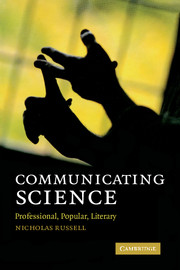Book contents
- Frontmatter
- Contents
- Introduction: What this book is about and why you might want to read it
- Prologue: Three orphans share a common paternity: professional science communication, popular journalism and literary fiction are not as separate as they seem
- Part I Professional science communication
- Part II Science for the public: what science do people need and how might they get it?
- Part III Popular science communication: the press and broadcasting
- Part IV The origins of science in cultural context: five historic dramas
- Part V Science in literature
- Index
- References
Prologue: Three orphans share a common paternity: professional science communication, popular journalism and literary fiction are not as separate as they seem
Published online by Cambridge University Press: 02 December 2010
- Frontmatter
- Contents
- Introduction: What this book is about and why you might want to read it
- Prologue: Three orphans share a common paternity: professional science communication, popular journalism and literary fiction are not as separate as they seem
- Part I Professional science communication
- Part II Science for the public: what science do people need and how might they get it?
- Part III Popular science communication: the press and broadcasting
- Part IV The origins of science in cultural context: five historic dramas
- Part V Science in literature
- Index
- References
Summary
NATURE SPEAKS
The weekly magazine, Nature, is a strange beast. It began in the mid nineteenth century popularizing science but has subsequently evolved into a leading technical journal for the scientific profession. Its original popular remit remains in a section where specialists explain the significance of their latest work for a wide readership. But the bulk of the magazine consists of ‘letters’ to Nature where scientists announce progress in exciting or fashionable fields. These letters make few concessions to the ordinary reader. In form, language and content they are written by professional scientists for professional scientists.
Nature also carries news and editorial opinion on matters of importance to the profession. The three editorials in the 27 March 2008 issue happened to deal explicitly with the three themes of this book; the professional, the popular and the literary communication of science. Their joint appearance in Nature suggests that the scientific community is aware of the importance of all three genres.
The editorial on professional communication concerned a paper on adult stem cells modified by genetic manipulation to behave as if they were embryo cells. The work is exciting because such cells can be used in research and disease treatment. The editorial worried about errors in a hastily prepared paper which the lead author admitted and plausibly explained. Cutting corners in the laboratory and in preparing documentation is a result of intense competition.
- Type
- Chapter
- Information
- Communicating ScienceProfessional, Popular, Literary, pp. xv - xxivPublisher: Cambridge University PressPrint publication year: 2009

